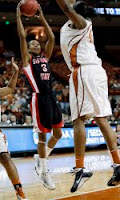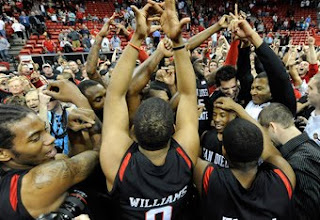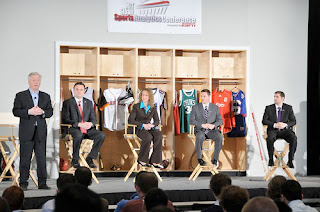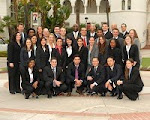Today, Verónica Nogueira (SMBA '09) explained more about what our trip to the Dominican Republic in June will entail. Verónica currently lives in the Dominican Republic and works for the San Diego Padres to ensure the continued success of the community outreach programs in the D.R.
Also, Raquel Rodriguez (SMBA '11) was nice enough to provide the rest of the class the following summary about the Dominican Republic trip:
San Diego Padres Community Outreach in the Dominican Republic
Mission: The San Diego Padres, committed to extending their long-standing domestic mission of reaching out to the community, have put in place a multi-faceted LIVE, LEARN, and PLAY program in the Dominican Republic. The main objective is to contribute to the improvement and reach of the education system, health and quality of life in the communities surrounding their new state of the art baseball academy located about one hour west of Santo Domingo.
What’s being done: The San Diego Padres and San Diego State University are working toward improving education in the Najayo public schools system, located in the San Cristobal region of the Dominican Republic.
The Padres-SDSU educational program is centered on improving the quality of teaching and student learning environments at the elementary school level. Immediate initiatives include: the establishment of five before and after school learning centers throughout the region and the travel of SDSU students from the Sports MBA program to the Dominican to participate in community projects in the Najayo area.
Currently, the one major project being worked on will be the community center, so this may be a major source for the money raised thru fundraising. The general idea is that once there is a community center a lot more programs can be run like technical courses, medical attention centers, sports, workshops, job generation, etc.
Goals of the program: To improve the quality of life and education of the Dominican people.
SDSU plans to provide faculty and students to develop teacher training programs, perform public health evaluations and assist with socio-economic development. As the partnership develops, SDSU students will also have the opportunity to study abroad in the San Cristobal region of the Dominican Republic and participate in hands-on community service learning projects.
About the Padres Dominican Republic Baseball Park:
Opened on April 29, 2008, the Padres Dominican Republic Baseball Park operates year-round and serves as the hub for the Padres Latin American baseball operations. The all-inclusive park includes two regulation-size playing fields and a half field, batting tunnels, a clubhouse, weight and training rooms, a dining hall and administrative offices. Additionally, the complex has housing for over 60 players as well as managers and coaches. In an effort to create a comprehensive training facility for the athletes, the club has incorporated on-site classrooms to further their education.
USAID:
USAID is an independent United States federal government agency that receives overall foreign policy guidance from the Secretary of State. USAID supports international development and advances U.S. foreign policy objectives by supporting economic growth, agriculture and trade, global health, democracy and conflict prevention; and humanitarian assistance in Sub-Saharan Africa, Asia and the Near East, Latin America and the Caribbean, and Europe and Eurasia.
USAID’s close partnership with the Dominican Republic goes back more than four decades. The current program is helping to address development challenges such as weak governance, inadequate rule of law, frail institutions, and poor service delivery; poor quality of public health care and basic education; a growing gap between rich and poor; and the need to adjust to a rapidly changing global economy.
USAID will serve as both a catalyst as well as donor for this alliance. Through the Program Office USAID will provide logistical, programmatic, planning and evaluation support to the MLB-DDA. In addition, USAID will provide resources that will serve as a match grant fund in order to provide incentives to MLB teams, players, agents and fans as they begin to explore options for investing in development initiatives with the Alliance partners.
The Major League Baseball Dominican Development Alliance (MLB DDA):MLB DDA implements community projects that focus on preschool and basic education, health, youth development, and economic development in the marginalized communities and neighborhoods in the Dominican Republic.
The MLB DDA is an alliance between Major League Baseball, the United States Agency for International Development (USAID), Batey Relief Alliance (BRA Dominicana), Esperanza International, the Dominican Institute of Integral Development (IDDI), Plan International, Save the Children (FUDECO), and World Vision. Inaugurated in November 2008, the alliance uses the influence of baseball to leverage resources from fans, players, teams, and sponsors to contribute to a country that has given so much to baseball.
In the Dominican Republic baseball is more than a sport. In addition to being a productive pastime for youth and adults, it represents a way of life and the hope to overcome poverty. Everyday boys and girls, arrive to baseball diamonds and open spaces in their neighborhoods and villages to tone their baseball and softball skills and to entertain themselves - but many arrive day after day with the hopes to make it to the Majors.
This desire is reinforced by the extreme poverty that many people experience. Some see baseball as the only path out of poverty. A selected few will see the playing time for a professional team and benefit from the fortune and fame that the job entails, but the others will eventually move on to other opportunities. MLB-DDA will harness this pivotal influence baseball plays in so many lives to promote community development projects focusing on education, health, youth development, economic development that will improve the lives of many Dominican habitants.
The MLB-DDA marks a new page in development partnerships by uniting the resources and brand of MLB with the financial support of USAID to support community development managed by the 6 allied non-profit organizations to improve the lives of the most afflicted people.
MissionTo leverage the influence of baseball in the Dominican Republic and the financial and human resources of member organizations to carry out at a national level sustainable development projects that focus on education, health, youth development, and economic development in underserved communities.
VisionTo implement strategies with the cooperation of Major League Baseball, the 30 teams, owners, players, agents, and fans in order to channel money to high-priority community projects in the Dominican Republic that will have positive, long-term impacts on the education, health, and well-being of the beneficiaries.
Preschool and Basic Education ProjectsThese projects focus on the quality of educations and infrastructure of schools located in marginalized communities. Projects include building and remodeling schools, training teachers, organizing after school and extracurricular activities, supporting schools with materials, among other activities.
HealthThese projects are directed towards improving the health awareness and prevention, offering access to professional medical attention, and promoting a healthy environment. Projects include HIV/AIDS awareness, the construction of aqueducts and water systems, the construction of latrines, medical missions that provide professional medical attention and surgery, malnutrition alleviation, vaccinations, trash recollection, organizing and training health promoters, community clean-up activities, among others.
Youth DevelopmentThese projects are geared towards teaching youth important life skills necessary to make good decisions and lead a successful life. Projects include youth camps and workshops that address issues such as youth rights and interfamilial violence, the construction of libraries and computer/internet centers, artistic and cultural events and workshops, youth group activities, baseball/softball league sponsorship, support for youth sports programs, among others.
Economic Development
These projects intend to increase sustainable economic activity in marginalized communities to improve family economic conditions and create job opportunities. Projects include microfinance to micro and small businesses, professional advice to small business owners and entrepreneurs, training in entrepreneurship and business concepts, support for farmers, among others.
Other Community Projects
The Alliance also focuses on many other community projects such as disaster relief and mitigation, remodeling and constructing houses, building community centers, and supporting other community initiatives.
 By Greg Leisher (SMBA '11)
By Greg Leisher (SMBA '11)
























